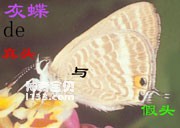1. Avoid the important and take the easy

In order to avoid harm from enemies, large mosquitoes can cut off their limbs to save their lives. The legs of large mosquitoes are thin and long, which are very eye-catching. They can easily fall off after being caught or touched. However, the insect itself will not be harmed, but it can take the opportunity to escape.

Most eye spots of butterflies are considered to be defensive "target areas" that can attract predators such as birds to capture them. Even if they are damaged, they will not endanger the butterfly's life, and some can still move normally. In many species of the family Lycosidae, the eyespot combines with structural features to form a "false head" at the inner corner of the hind wing. A small tail process often extends from this part of the wing. When these butterflies are perched, their wings are closed and rubbed, causing the tail process to vibrate, as if the antennae on the head are moving.

2. Armed Forces-Soldier Ants

Termites, which damage large amounts of wood every year, are even more capable of defending themselves. Soldier termites have a pair of hard and sharp jaws (can destroy lead!), which are powerful defensive weapons. They also secrete venom, which is applied to the skin wounds of enemy insects bitten by their upper collars, making the injured enemy insects safe. Fate is over.
3. Pretend to be dead and escape
Have you ever seen a "dead" insect come back to life? That's the insect pretending to be dead. If you go to a wheat field and you touch the wheat leaves a little, sometimes the armyworm larvae or wheat leaf wasps sitting on the leaves will roll up and fall to the ground before they even touch the wheat. If you go to the vegetable field, the same goes for the beetles on the vegetable leaves. Before your hands can catch it, it has already rolled into the heart of the vegetable. We call these phenomena suspended animation.
Does the insect really know that someone is going to catch it, so it quickly pretends to be dead? Of course not, how can insects be so smart! The suspended animation of insects is actually a very simple stimulus response. Because when their eyes or the sensory hairs on their bodies sense some changes in the surrounding environment, the nerves will send signals to cause the insects' muscles to contract. As soon as the insect's muscles contract, the legs that were originally resting on the plant will retract, and its body can no longer stop, so it rolls down on its own. If you don't believe it, you can pay attention to see if the legs of insects pretending to be dead are tightly closed. If they are really dead, most insects have loose legs. This method can also be used to tell whether a bug is really dead or fake.
Suspended death is a way for insects to avoid predators. For example, a bird wants to peck at an insect, but before the bird flies to the insect, the wind has already made the insect feel it. By the time the bird landed, the bug had already rolled away.
4. Fright colors and warning colors

Many butterflies, such as eye butterflies and gorge butterflies, usually appear with gray-colored reverse wings and are difficult to spot. When attacked, they suddenly open their wings and reveal large eye spots to scare away enemies. Based on this, a Japanese entomologist used balloons with "big eyes" painted on them and placed them in rice fields and orchards. Birds stopped visiting them, and he subsequently became a famous "bird repellent expert." All Nippon Airways asked him for advice on solving the problem of aircraft and bird collisions. He painted "magic eyes" on the engine fan blade shafts of 38 passenger planes. As a result, accidents have been greatly reduced.
5. The art of protecting oneself by sacrificing one’s tail

The silverfish has three tail barbels, which are long and segmented, and are longer than its body. These three tail whiskers not only function as antennae, but also as accessory organs for movement. When the silverfish crawls on the wall, its tail is close to the wall, and the dense short hairs on it can help and prevent it from sliding down. In order to prevent predators such as spiders from predating, silverfish always swing their tail tips constantly when resting, inducing natural enemies to focus on the tail tips. When the tail whiskers are caught, the segmented tail whiskers are broken off. The body can then take the opportunity to escape. This can be regarded as a self-protection technique.
6. Aphids also have soldier aphids

We all know that termites, social insects, have soldiers who specialize in work, but we have never heard of aphids having soldiers. However, soldier aphids do exist among some aphids. The Japanese Alexander aphid is one of them. Its front legs and upper jaw are very developed, forming a powerful fighting weapon.
7. Amazing disease resistance
In the vast nature, parasites and pathogenic bacteria are everywhere. How do insects avoid diseases? They have their own methods. The thick epidermis can block the invasion of pathogens. Blood cells such as phagocytes in the body can coat, engulf, and digest pathogens. At the same time, body fluids can produce many antibody proteins and enzymes to eliminate dissidents. Mosquitoes and fleas, which can spread a variety of diseases and bring endless disasters to humans, can live freely even though they are full of toxins. Flies that breed in filth and haunt places of right and wrong carry countless "bacterial bombs" on their bodies, but they are safe and sound. Scientists have discovered that flies possess an antibacterial protein that is unmatched by any antibiotic produced by humans so far. It would be great if humans had this kind of protein! Studying various immune responses of insects will undoubtedly promote the development of human medicine and bring good news to the world.
8. The art of escaping
You can still run away if you are discovered. Insects are extremely capable of escaping, and their wings are their most effective tools. Friends who love insects know that dragonflies and other insects fly very quickly, so catching them can take some effort. Killing pesky flies is not easy either, as they have sensitive antennae and compound eyes. The jumping of locusts must leave a deep impression on you. Fleas are the absolute high jumping champions in the biological world. When the dragonfly larvae encounters an enemy, it tightens its stomach and drains water from the anus. Its body is like a rocket. It can rush forward 10 centimeters at a time, then rush again, and escape quickly.
9. The protracted war between man and insect
Humans have suffered from pests since ancient times. They destroy crops, spread diseases, chew through stored materials, endanger the health of livestock, and destroy buildings. Humanity has a long history of fighting against pests. As early as the Zhou Dynasty, 23,000 years ago, there were records in our country of using "Jiacao to remove beetles, Mangcao to smoke out beetles, and burning rocks to remove small insects." Wang Chong (27-97 AD) of the Eastern Han Dynasty wrote "Lunheng." "Shungu Chapter" introduces in detail the physical prevention and control methods of digging ditches to catch locusts. Jia Sixie of the Later Wei Dynasty (528-549) described agricultural control techniques for planting insect-resistant varieties in his "Essentials for Qi Min". Liu Xun, Emperor Zhaozong of the Tang Dynasty (889-904), described the world's earliest biological control method in his "Lingnan Records", which was to use the natural enemy yellow deer ant to control pests in orange orchards. Xu Guangqi's "Agricultural Policy Complete Book" proposed the idea of eradicating locust breeding grounds to eradicate locusts, and also emphasized the importance of grain and cotton rotation to prevent and control pests. At this time, the idea of pest control focused on "treating" pests after they occur, rather than "preventing" them in advance, and the methods used were quite simple. Therefore, if there is a large outbreak of pests, there will be nothing you can do. Although people have been working hard to conquer this tiny but tenacious enemy, there is no good way.
It was not until the 1940s, due to the synthesis of the chemical pesticide DDT, that pest control entered a new historical period. DDT and the new organic pesticides developed successively such as organochlorines, organophosphorus and carbamates are so efficient, broad-spectrum and convenient that most people think that the problem of pest control has been basically solved. These pesticides can kill a variety of pests and save food, clothing, and lives. People shout long live, thinking that they can sit back and relax from now on. This optimism is also reflected in our country, where farmers refer to these agents as "clean sweeps." However, contrary to expectations, people are becoming more and more dependent on pesticides. Almost every village has a pest control team, and people carry buckets of pesticides every day to achieve "treating pests when there are pests, and preventing pests when there are no pests", in an attempt to eliminate pests cleanly and completely. Sadly, however, pesticides are not a panacea. The excessive and unreasonable abuse of pesticides has caused a series of environmental and social problems. The main manifestations are: ① natural enemies are killed, causing pests to become rampant again; ② pests react to pesticides. Resistance to pesticides has led to a vicious cycle of increased costs and environmental pollution; ③ The amount of pesticide residues in agricultural and sideline products has increased, endangering human and animal health. This series of negative consequences has made people clearly realize that it is not feasible to rely solely on chemical control to control pests, and it is absolutely impossible to completely eliminate pests. Therefore, people adopted an integrated pest control method based on agricultural control and coordinated biological control and chemical control, and achieved great results.
In recent years, pest control technology has made new progress. For example, genetic engineering technology can be used to introduce insect-resistant genes into crops to make crops resistant to pests; or to transfer insecticide-resistant genes to natural enemies to improve the genetic composition of natural enemies and make them resistant to insecticides, thereby improving Its ability to control damage in the field. In addition, a new generation of regulatory pesticides such as phytochemicals with little side effects on humans and animals, insect growth regulators, insect antifeedants, and insect attractants also play an important role in pest control. For example, the Institute of Zoology of the Chinese Academy of Sciences artificially synthesized this sexual pheromone based on the characteristics of female bollworms relying on sexual pheromone to attract male worms for mating. After soaking it in a rubber core and putting it into the field, the male worms in the field can be attracted. Attract a large number of them to achieve the purpose of controlling cotton bollworms.
So far, insects will develop resistance to any chemical agent if it is used for a long time. This shows that the defensive ability of insects is formed in the long-term adaptive evolution and has extremely strong vitality. Although biological control is beneficial, it is slow to produce results and there are still many unresolved problems, making it difficult to achieve the purpose of sustained pest control. The protracted war between man and insect is far from over.
animal tags:
We created this article in conjunction with AI technology, then made sure it was fact-checked and edited by a Animals Top editor.